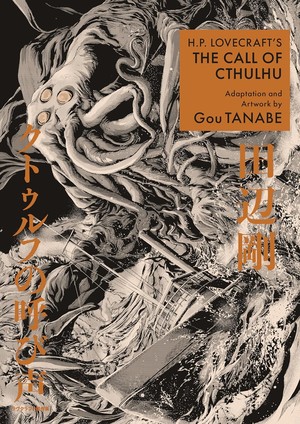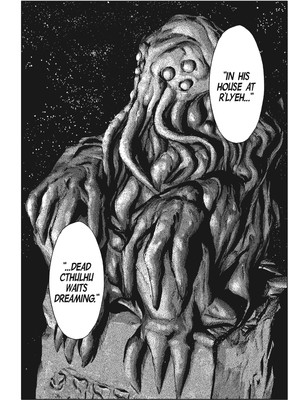The Fall 2024 Manga Guide
The Call of Cthulhu
What's It About?

H.P. Lovecraft's most famous horror story, rendered in chilling detail by modern manga horror master Gou Tanabe!
The complete graphic novel in one volume, faithfully reproducing the original Japanese release, featuring a title page in silver ink, eight pages in full color, and eerie metallic copper tones and spot color on the cover.
What links together two bands of worshippers, one deep in the Arctic snows, one hidden in the bayous of Louisiana, is more than their shared practice of blood sacrifice.
It is the inhuman phrase they both chant: Ph'nglui mglw'nafh Cthulhu R'lyeh wgah'nagl fhtagn—“In his house at R'lyeh dead Cthulhu waits dreaming.” Now these nightmares will disturb the sanity of Francis Thurston, a young man pursuing an investigation into the cult of Cthulhu that leads to the most forsaken spot in the vast Pacific…and to Earth's supreme terror, the risen corpse-city of R'lyeh.
First published in 1928, The Call of Cthulhu, rendered in chilling detail by modern manga horror master Gou Tanabe, is the most famous of all of H.P. Lovecraft's stories, and was the namesake of the acclaimed role-playing game system set within the Cthulhu Mythos.
The Call of Cthulhu is adapted from a short story of the same name by H.P. Lovecraft. Adapted with art by Gou Tanabe, with English translation by Zack Davisson. This volume was lettered by Steve Dutro. Published by Dark Horse Manga (October 15, 2024).
Is It Worth Reading?

Rebecca Silverman
Rating:
There's something about Gou Tanabe's manga adaptations of H.P. Lovecraft's works that substantially enhances the original. That's not to say that Lovecraft's stories can't stand on their own, but rather that seeing them in Tanabe's style provides modern readers with something of the experience of reading them as they appeared (or would have appeared; Lovecraft wasn't widely published in his lifetime) in the pulp magazines of the 1920s and 1930s, which typically had illustrations. In fact, if you look up the Tales of the Weird original printing of The Call of Cthulhu, you'll find an illustration that looks remarkably like Tanabe's in its line quality and busyness. All of this is to say that this manga, like Tanabe's other Lovecraftian works, is an adaptation worthy of the original.
One of the few pieces to see print during his life, The Call of Cthulhu is arguably Lovecraft's most influential tale. This version makes it easy to see why – various inspirations are clearly laid out in the art and text, with the final two chapters calling to mind Bram Stoker's telling of how Dracula came to England and the New Orleans-set chapter functioning as a snapshot of the bad old days and how non-Abrahamic religions (or just non-Christian religions) were seen in the early twentieth century. Tanabe largely avoids racist iconography, although some are present; that's not great, but it hardly needs to be said that a story published in 1928 isn't going to adhere to our standards today. Instead, the imagery is more focused on the interplay of darkness and shadows, with the Great Old Ones mostly depicted in small statuettes or obscured by the night. We finally see a full image of them in the final chapter, when the survivors of the schooner Emma accidentally make port in Cthulhu's homeland, temporarily rising to the surface following an earthquake. This allows the terror and horror to build throughout the book – we know what they look like in miniature and what they can cause people to do, so by the time we finally see one in person, the tension has built to a truly impressive point.
The darkness of the art can make it difficult to read at times, although I can't be certain that's not purposeful. This is an impressively crafted book, faithful to the original text and enhancing connections to both its own inspirations and the later dark fantasy and horror works that took inspiration from it. Lovecraft fans likely are planning to read this, but if you're curious about the Cthulhu mythos and not a fan of early twentieth-century prose, this is a great way to dip your toe in…as long as nothing grabs it.

Kevin Cormack
Rating:
Even readers who have never once delved between the pages of H.P. Lovecraft's febrile prose are still likely to have heard of Cthulhu, if not the wider mythos of indifferent Elder Gods, former rulers of Earth who in their slumber still sow dread amongst the souls of men. So influential was Lovecraft's unsettling imagination that modern fantasy and horror authors owe him a substantial debt. This stunningly detailed manga edition skillfully adapts Lovecraft's 1928 short story that introduced the world to the titular, enormous tentacle-mouthed abomination, and the festering madness of his followers.
Esteemed horror mangaka Gou Tanabe has made a career of bringing Lovecraft's Mythos to life with his meticulous, detailed manga, and The Call of Cthulhu follows Dark Horse's similar editions of At The Mountains Of Madness and The Shadow Over Innsmouth. Tanabe's art is dark, filled with shadow and creeping unease. His characters appear haunted, with wide eyes and gaunt expressions, as they relate indescribable visions, or tales of secretive cults and vile rituals.
To modern eyes, Lovecraft's writing can present as purplish, florid, even a little quaint. Tanabe's adaptation does little to update the original text, in fact some panels are little but entire paragraphs of prose lifted more or less straight from the original. This means the pace flags, especially at the beginning when the story is told mostly via endless conversations between talking heads, or related from journals.
Once Tanabe finds opportunity to draw the stranger, more exotic aspects of Call of Cthulhu, the art comes alive with queasy, glistening horror. Tanabe's attempts to do justice to Lovecraft's description of sleeping Cthulhu's drowned abode R'lyeh, with its cyclopean architecture, non-Euclidean geometry, and blasphemous inscriptions, are nothing short of remarkable. While this is a very different type of horror to the modern gore-filled slasher or cheap jump scare story, Tanabe's art unsettles and fascinates in equal measure.
Lovecraft's works aren't for everyone, and Call of Cthulhu's dour, humorless trudge through the depths of cosmic horror isn't so much enlivened my the manga format as enriched. This edition is unlikely to attract new fans, as even in manga form it's heavy going, but I very much appreciated the excellent, atmospheric art. I'd like to check out more of Tanabe's work in this particular vein.
Disclosure: Kadokawa World Entertainment (KWE), a wholly owned subsidiary of Kadokawa Corporation, is the majority owner of Anime News Network, LLC. One or more of the companies mentioned in this article are part of the Kadokawa Group of Companies.
discuss this in the forum (25 posts) |
this article has been modified since it was originally posted; see change history
back to The Fall 2024 Manga Guide
Seasonal homepage / archives